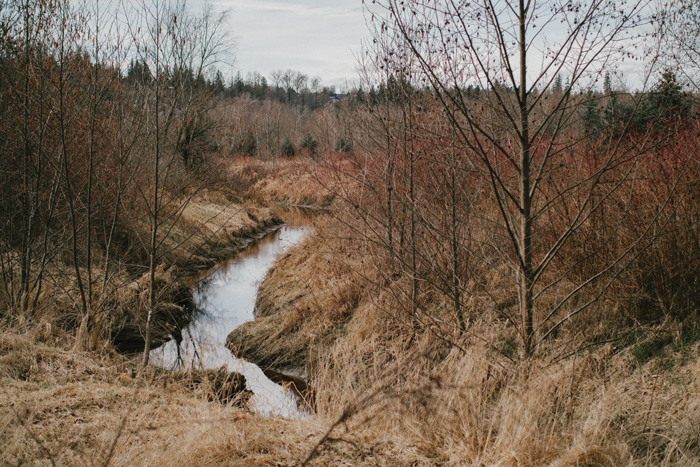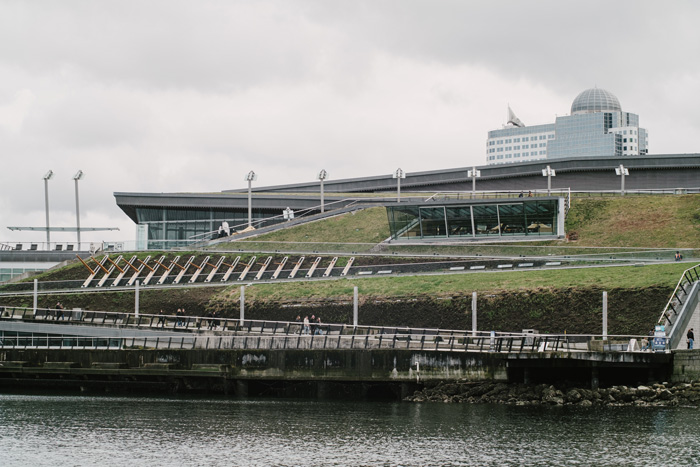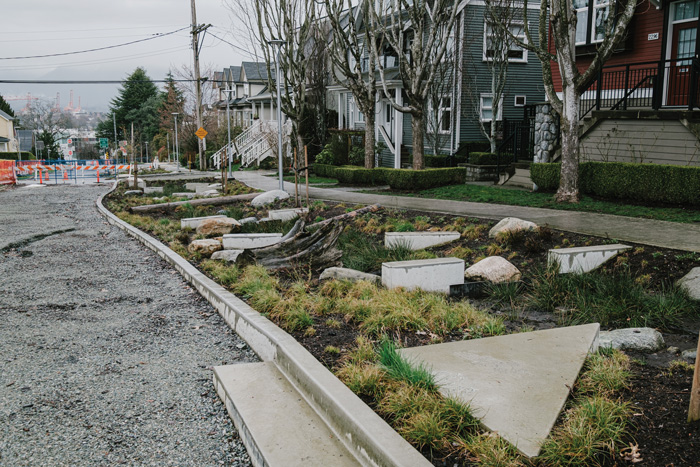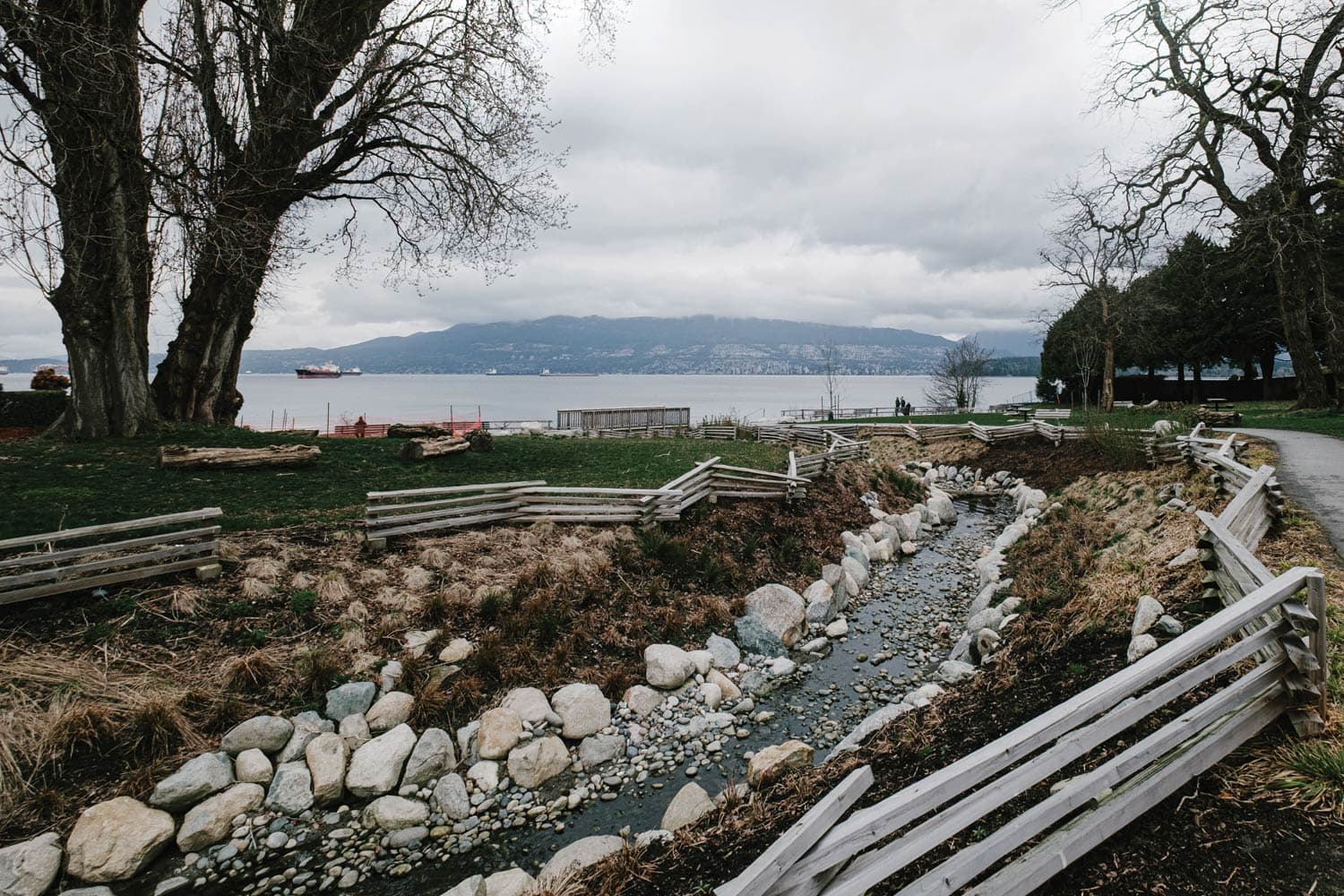Vancouver’s Got the Green Infrastructure Blues
Can water sustainability champions shore up the region’s ebbing political will?
The City of Vancouver has daylighted a stretch of Tatlow Creek in two Kitsilano-area parks. In East Vancouver, the stretch of Renfrew Creek under Hastings Park pavement remains buried, despite a decades-old plan to unearth it.
The vision of green infrastructure in Metro Vancouver is a beautiful one: with this nature-based approach to managing rainwater fully realized, the region is bejewelled with the greens and blues of lush tree canopies and thriving wetlands. The roofs of city buildings flourish with flowering plants and trees, forming a vast rain-capture network that reduces runoff and cools urban heat islands.
Rain gardens in every backyard catch water from downspouts and hard surfaces in their reeds and shrubs, filtering the water before releasing it into the ground. Oily runoff from asphalt surfaces flows into bioswales—vegetation-lined channels—to be slowed and cleaned by trees and grasses. Long-buried urban streams are brought back into daylight, their sparkling waters supporting fish and other wildlife.
The reality is…well, a lot greyer.
When rain falls in Metro Vancouver, almost all of it flows over polluted hard surfaces into an aging, inadequate traditional infrastructure system made up of about 2,130 km of sewer pipes. When it rains heavily, the water overwhelms this system, often called “grey infrastructure,” causing “combined sewer overflows”: events in which sewage pipes send human feces into rivers, inlets, and the ocean instead of wastewater treatment plants. With water bypassing the soil and funnelling into the nearest waterways, the ground grows dry and hard, leading to dying trees, low water levels in creeks and rivers, a higher risk of wildfires, and more severe flooding.
And the problem is only getting worse. Between 2014 and 2020, the 20-plus municipalities that make up Metro Vancouver paved over an area equal to nine Stanley Parks and lost 250 square km of natural habitat. The region’s tree canopy coverage shrank to 31% and is predicted to reach 29% in the coming decades as development continues. A 2023 mapping project showed that of the nearly 10,000 buildings in Vancouver’s downtown area, only 3% have green roofs.
Gaps between vision and reality are, of course, standard in politics. What makes this one frustrating to water-sustainability experts is how close to success the green infrastructure push came before it got derailed. Through decades of effort by politicians, civil servants, advocates, and experts, planning had become policy, and policy had started to become practice. Now the question is whether the high profile of floods, droughts, and population growth will put green infrastructure back in the spotlight—and, if so, whether the decision-makers within Metro Vancouver’s municipalities will correct course.
Four eras
If history is anything to go by, the chances seem dim. Longtime water-sustainability advocate Kim Stephens—an engineer-planner who runs intergovernmental liaison group the Partnership for Water Sustainability in BC—has outlined the past 40 years of the region’s green-infrastructure movement in his 700-page Chronicle of Green Infrastructure Innovation in Metro Vancouver (to be released in phases starting April 1, 2025). He breaks the movement into four distinct eras: the “Crucible Period” (1997–2005), “Golden Period” (2006–11), “Unfulfilled Promise” (2012–17), and “Memory Loss” (2018–24).
In Stephens’ view, what makes the difference between the success and the failure of green infrastructure efforts is the presence or absence of nine factors, including shared vision, political commitment, champions, and funding. In the first two periods, all nine factors were present. By the fourth, none were.
“Collectively, we worked so hard to get everything in place,” Stephens told me during a Zoom interview. “And then you realize how easy it is to undermine it. Things started falling off the table.”

Stephens believes that the initial burgeoning of Metro Vancouver’s green-infrastructure movement arose from the combination of committed politicians and public zeitgeist. “Everything was in alignment from top to bottom,” he says. “You don’t realize until after the fact how important political leadership is. Not that they have to understand the details, but they have to understand the context and the need.”
Driven, Stephens says, by both a high-profile campaign to save wild Pacific salmon and fallout from previous decades’ unchecked urban development, politicians and advocates at the local, regional, and provincial levels came together in the late 1990s and early 2000s to create green-infrastructure groups and policies. In 1998, Premier Mike Harcourt created the Georgia Basin Ecosystem Initiative, gathering leaders from Vancouver Island and Metro Vancouver to plan sustainable management of the Straits of Georgia and Juan de Fuca.
Another initiative, the SmartStorm Forum Series, convened experts and officials from southwestern BC to discuss a natural-systems approach to handling rainwater. The series filled 250-seat venues with elected officials, municipal staff, water experts, and members of the public, and provided impetus for other early milestones, including the BC government’s 2002 Stormwater Planning: A Guidebook for British Columbia (co-authored by Stephens).
Leading the way
Organization began turning to visible action. Both larger natural green infrastructure elements (like forests and wetlands) and smaller human-made ones (like vegetated roofs, rain gardens, and bioswales) began to proliferate.
In 1995, the City of Surrey began buying ecologically sensitive land slated for industrial development along the Fraser River, and, in 2004 Surrey, and Metro Vancouver developed a plan to create what is now the 348-hectare Surrey Bend Regional Park on that land. Completed in 2016, it’s one of the few places in the region where the undyked river is allowed to spread into a natural floodplain.
In 2000, the City of North Vancouver “daylighted” Thain Creek, removing 200 metres of concrete culvert to restore a fish-bearing channel with clear waters and densely planted sides.
A 2004 approach to adding green space to Hastings Park in East Vancouver included a similar unburying of Renfrew Creek, which runs beneath the asphalt of a parking lot. An initial 155-metre stretch of the creek north of Hastings Park was fully daylighted in 2013. With shallow waters flanked by pollution-filtering reeds, granite boulders, flowering shrubs, and nesting boxes for songbirds, Creekway Park offers a vital ecological corridor within the surrounding industrial lands.
When rain falls in Metro Vancouver, almost all of it flows over polluted hard surfaces into an aging, inadequate traditional infrastructure system.
On Simon Fraser University’s mountaintop Burnaby campus, sustainability-focused development begun in the early 2000s saw new housing construction use entirely green infrastructure—including bioswales, tree retention, and a network of streams and wetlands—for rain management. The official plan mandated that “no standard stormwater pipes are used within the community, with the exception of overflow facilities to safely convey extreme rain events.”
In 2005, the developers converting industrial land in southeast False Creek to athlete housing for the 2010 Olympics set the ambitious target of earning the highest possible designation from the international Leadership in Energy and Environmental Design (LEED) program. In addition to net-zero-emission buildings, green roofs, and permeable pavers, designers included a wetland—now replete with bulrushes and red-winged blackbirds—and a small island wildlife sanctuary protruding into False Creek, planted with more than 200 native trees and naturalized plants. Olympic Village would become only the second project in the world certified LEED Platinum for neighbourhood development.
“In the mid-2000s,” Stephens says, “everybody in North America was looking to this region. We were the leaders.”
The disconnect connection
As politicians and advocates looked for alternative ways to handle water, one obvious option appeared: taking roof runoff out of the main sewer system. This could be done quickly and easily through property owners cutting off the bottoms of their downspouts and bending them toward a patch of ground rather than down into a sewer pipe, something called “downspout disconnect.”
From 1996 to 1998, the City of Vancouver ran a public downspout-disconnect pilot project that urged Vancouver homeowners to “help protect our environment by taking part in this program,” gave detailed disconnection instructions, and offered them the services of an inspector.
All this made for fertile conditions when retired librarian Deborah Jones went to Delta City Hall in 2006 to ask about creating a rain garden—a plot of absorbent materials and water-tolerant plants (often located at the receiving end of a disconnected downspout) that allows rainwater to seep into the soil and be gradually released to tree roots and waterways.

As a leader of North Delta’s Cougar Creek Streamkeepers, Jones had become aware of what she calls “the twofold problem” of managing rainwater through grey infrastructure. “Either there’s a torrent of polluted water flowing in when it rains,” she told me over coffee, “or the creek is getting less and less natural seepage because we haven’t allowed that rainwater to soak into the ground.”
Realizing that “you can’t just fix the creek: you have to treat the entire watershed area,” Jones and other Streamkeepers decided that creating public rain gardens near the creek would be the wisest option.
At the City of Delta—then led by green-minded mayor Lois Jackson—Jones found a receptive audience. Not only did Jackson give her the go-ahead, but then-utilities manager (and later deputy director of engineering) Hugh Fraser suggested the site of Cougar Canyon Elementary School. “It proved to be a brilliant thing,” Jones said, “because it’s such a hook into the community.”
Once the garden was created, Jones dedicated the next three years to keeping it looking good, mindful that “one of the biggest concerns of the city is that… something ends up being a mess.” Her diligence paid off: in 2009, Jackson and council decided that every elementary school in Delta should have a rain garden. By 2014, Jones, volunteers, and students had created them at all 14 of North Delta’s elementary schools.
How green was our roofing
Beyond initiatives like downspout disconnection and rain gardens, municipalities signalled a deeper commitment to green infrastructure by exploring the more complex option of green roofs. Planted with grasses, flowering plants, and small trees, these roofs absorb rain and—when there are enough close together—cool the surrounding air. Whether included in new builds or retrofitted, a planted roof requires the involvement of engineers and other experts.
As the green-roof movement developed in Europe and North America, a dedicated green-roofs research facility created on the British Columbia Institute of Technology’s Burnaby campus in 2002 became a major hub. Christine Thuring, now the chair of the Green Roof Infrastructure Network (GRIN), taught in BCIT’s program and remembers the profile it had: “Any question about green roofs, it’s all here.”
Seattle’s efforts started only slightly ahead of Metro Vancouver’s, but the city now captures 47 times more rainwater through green methods than Vancouver does.
Enough momentum built that, by 2018, Vancouver City Council passed Green Party Councillor Adriane Carr’s motion to create a policy requiring green roofs on new buildings and providing “maximum opportunity” to have them retrofitted in existing ones.
Buoyed by the impetus, the City of Vancouver created a Rain City Strategy that set ambitious targets. “Capture and treat 90% of rainfall using green infrastructure tools,” trumpeted the strategy’s 2019 manifesto. “Capture and clean 48 mm [of rainfall] in streets and public spaces… for private property by 2022, capture and clean 48 mm.”
It all seemed golden. “I just assumed everyone was seeing the light and would continue to do so,” Jones wrote me in an email.
Paradise lost
By around 2005, it looked like Metro Vancouver was on pace to become a green-infrastructure paradise. Instead, momentum slowed, then stalled—then began moving backwards to create the grey reality that we see today.
For water-sustainability expert Stephens, the chief factor behind the failure basically amounts to lack of succession planning. Key green-infrastructure champions began to retire, taking their passion and decades of experience with them. As they left, what Stephens calls “organizational amnesia” began to take hold.
In local politics, longtime organizers were replaced by candidates who were, in Stephens’ words, “really good on social media” but less connected to the community. At the provincial level, he says, it took many years for green-infrastructure advocates to understand the impact of BC premiers Gordon Campbell and Christy Clark having hollowed out the civil service. Says Stephens, “Just when you need that knowledge, you don’t have it.”
For green-roof expert Thuring, signs of trouble came when she noticed Metro Vancouver’s leadership “digging in its heels so hard compared to most parts of the world” that had been part of the green-roofs revolution. Despite the region’s early promise, she says, the green-roofs movement “has definitely not grown in the way anyone expected it to.”

In fact, BCIT’s vaunted green-roofs program was an early victim of this ebbing tide. After its founder, Maureen Connolly, stepped down, students stopped registering and the program quietly died. Thuring says she and colleagues wondered, “How could BCIT close this program? It’s one of the things it’s so proud of.” Now, she notes, “there are five new buildings going up on that campus, and not one of them has a green roof.”
Vancouver Councillor Carr’s 2018 green-roofs policy died even more quietly. Talking to Carr in early 2023, Thuring was surprised by the then-councillor’s mention of the bylaw. “I was like, ‘Adriane, there’s no bylaw.’” When Carr investigated, city staff told her, “No, sorry, we haven’t figured it out yet”—five years after the motion had passed.
Carr herself, echoing Stephens’ belief that a loss of strong leaders led to the momentum shift, says of her proposed bylaw’s disappearance, “I feel there was a lack of leadership on the part of the mayor [Kennedy Stewart]. City staff were overwhelmed by all the motions and didn’t know which ones to prioritize.”
Cougar Creek Streamkeepers’ Deb Jones also has been disappointed in the lack of liftoff for Delta’s rain gardens. Since creating that first garden, she says, “it’s been kind of one rain garden a year, one rain garden a year. [That] doesn’t really cut it in relation to the size of the problem.” While she appreciates current mayor George Harvie continuing Delta’s rain-garden policy, she wishes more governments would recognize these gardens’ economic and ecological value and take a “water first” approach to land-use planning: “Our aim should be to everywhere mimic nature’s brilliant system of storing rainwater in the ground.”
One metric of the overall failure of the region’s green-infrastructure movement: Seattle’s efforts started only slightly ahead of Metro Vancouver’s, but the city now captures 47 times more rainwater through green methods than Vancouver does. Likewise, Germany, which jumped on the green-roofs trend at the same time as Metro Vancouver, now has 120 million square metres of green roof and is adding around 8 million square metres a year, about 8% of all new flat roof area in the country.
Meanwhile, rainwater-capture regulations in Metro Vancouver have been going backwards. A 2023 Vancouver City Council meeting proposed a developer-endorsed “simplified approach to rainwater management.” Among other things, it recommended that water-management-plan requirements be removed from the development application process and that developers be allowed to capture the first 24 mm of rainfall (down from the 2019 objective of 48 mm) using “any combination of strategies.” These strategies can include a green roof—or not.
Thuring and Jones identify the main obstacle to getting projects greenlit as “engineers afraid of liability.”
Melina Scholefield, who heads the City of Vancouver’s Rain City Strategy, notes that grandfathered regulations can also be a serious obstacle. In a 2021 interview with the Richmond News, she cited a longstanding regulation that bans any kind of green infrastructure within 3 metres of a drinking-water pipe—effectively putting half of Vancouver’s roads off-limits.
Both Thuring and Jones identify the main obstacle to getting projects greenlit as being, in Jones’ words, “engineers afraid of liability.”
Stephens doesn’t disagree. “I’m an engineer, so I get to say this, right? The engineering profession gets obsessed with numbers but loses sight of nature.”
However, he sees balky engineers as part of a larger culture of risk aversion, one that momentum and passion had previously overcome. “We were all collectively willing to take a leap of faith and try something,” Stephens says. “You only have that mindset if you feel like you’re part of a movement.”
A tale of two hills
On October 19, 2024—provincial election day in BC—an atmospheric river hit the west coast of BC and Washington State. Over the next three days, it deluged the area with record rainfall: 265 mm in Coquitlam, 211 in Vancouver, 190 in West Vancouver.
The stormwater overwhelmed the North Shore’s grey infrastructure. Even though the municipality had just spent tens of millions to upgrade storm infrastructure, District of North Vancouver Mayor Mike Little told the North Shore News, “It still failed.” The debris churned up by the storm blocked catch basins, turning streets and yards into raging rivers. At the foot of the hill in Deep Cove, landslides sent rivers of mud, boulders, and trees through homes. A sinkhole opened up. Hundreds of homes were flooded, many were heavily damaged, and six were evacuated after a retaining wall was compromised.
Meanwhile, in East Vancouver, a not-yet-completed curbside rain garden on four blocks of St. George Street was already proving its worth. The rainwater that raced down the steep street sloughed harmlessly into the garden’s bioswales; the basement flooding that major rainfall typically caused on St. George did not happen.
Robb Lukes, the city’s associate director of green infrastructure, told the CBC several days after the storm, “It performed beautifully.”

Paradoxically, the increasing frequency of storms like this one has Stephens optimistic about the future of green infrastructure in Metro Vancouver. In fact, when asked how hopeful he is that sustainable water management will regain momentum, he says, “I’m going to say either a nine or a 10.”
Originally, he says, the public impetus was saving the salmon. Now, he says, “The only way you can reach people is through risk and liability.” With the election-day storm’s insured losses alone reaching an estimated C$110 million and combined sewer overflows sending untreated sewage into local waters dozens or even hundreds of times a year, the status of green infrastructure as both urgent and important is becoming clear.
The timing is good for the third iteration of Metro Vancouver’s Liquid Waste Management Plan (LWMP), which includes rainwater. Stephens acted as a consultant to the plan; Jones sat on its public advisory committee. The involvement of the Tsleil-Waututh, Tsawwassen, and Semiahmoo First Nations has put emphasis on natural methods of managing rainwater. The new LWMP is in its final phase; if each municipal council in the region approves it, the provincial government will sign it into law.
“It’s all there,” Stephens says of the plan. But he also cautions that, should the vision fail once again, there is no time for do-overs. “In terms of the ‘streams and trees’ component, this will either be the last stand or the beachhead.”
Some faint stirrings within local government may support Stephens’ hopes. A January 2023 update to Vancouver City Council on the city’s sewage and rainwater management plan noted it was building on “nearly two decades” of green infrastructure leadership and projects in the area. Nearly three decades after the City’s original pilot program, the report urged leaders to explore, among other things, “the implementation of a ‘Downspout Disconnection’ pilot project,” to motivate people to reduce the amount of rainwater entering the drainage system. “Portland and Toronto,” the report notes, “are recent examples.”
This story was first published on The Green House, our membership platform. Join us there for early access, discounts and freebies, community discussions, and to support our work telling the large and small stories of how we can live sustainably.
Print Issue: 2025—Issue 1
